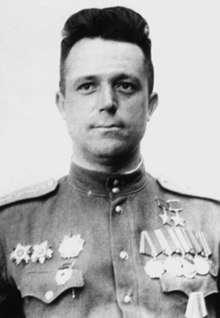Vitaly Popkov
Vitaly Ivanovich Popkov (Russian: Виталий Иванович Попков; 1 May 1922 – 2 June 2010) was a Soviet fighter pilot who became a flying ace during the Second World War, credited with 41 aerial victories. He was also a two-time Hero of the Soviet Union.
Vitaly Ivanovich Popkov | |
|---|---|
 | |
| Native name | Виталий Иванович Попков |
| Born | 1 May 1922 Moscow, RSFSR |
| Died | 2 June 2010 (aged 88) Moscow, Russian Federation |
| Allegiance | |
| Service/ | |
| Years of service | 1940 – 1989 |
| Rank | General-Lieutenant of Aviation |
| Unit | 5th Guards Fighter Aviation Regiment |
| Battles/wars | World War II |
| Awards | Hero of the Soviet Union (twice) |
Biography
Popkov joined the Soviet Army in 1940 and graduated from the Chuguevskaya military-aviation school of pilots in 1941. After graduation from the Chuguev military aviation school in May 1941, he remained to become an instructor with the rank of sergeant. He was soon transferred to a school at Bataisk. Soon after the Germans launched Operation Barbarossa in June 1941, Popkov was posted to a fighter regiment supporting Soviet forces on the Kalinin Front, northwest of Moscow.
In March 1942 during the Soviet winter counter offensive, Popkov made his first aerial victory near Lake Ilmen. In his first three months at the front he flew over 100 combat missions and shot down four enemy aircraft.
In late 1942 Popkov's unit participated in the defence of Stalingrad. He was wounded three times and shot down twice. He claimed a further five Junkers Ju-52 transports and six Bf. 109 fighters.
In August 1943 Popkov took command of a fighter squadron in the 5th Guards Fighter Aviation Regiment of the 295th Fighter Air Division. Flying the Lavochkin La-5, he continued to add to his victory tally, shooting down three Messerschmitts near Kharkov, and three more near Kiev.
During service over the Crimea, Leningrad and at the battle of Kursk Popkov flew 478 combat missions and took part in 117 air combats, from which he personally claimed 41 enemy aircraft shot down (1 by ramming) and 1 victory shared.
He eventually became commander of 5th GIAP Guards Fighter Regiment, 207th Fighter Aviation Division, 3rd Mixed Aviation Corps (17th Air Army) on the South-Western Front, mainly flying the Lavochkin LaGG-3, La-5, La-5FN, and La-7.
He was also squadron commander (comesqa) of 5 GIAP, 11th Fighter Aviation Division, 2nd Guards Assault Aviation Corps (2nd Air Army) on the 1st Ukrainian Front.
Post war he graduated from the Red Banner Air Force Academy in 1951, and then served with the General Staff Academy to 1964, being promoted to Lt. General of Aviation in 1968. He flew 25 types of aircraft and helicopters during service with the Ministry of Defense, USSR.
He then taught at the Military Engineering Academy until 1980.
His biography became the basis of the 1973 film Only Old Men Are Going to Battle[1] directed by Leonid Bykov as the prototypes of Comesqa Titarenko a.k.a. Maestro (portrayed by L. Bykov himself) and Kuznechik (portrayed by Sergei Ivanov). A bronze bust of Popkov was erected in 1953 in Moscow on Samotechnaya Square.
Awards
- Twice Hero of the Soviet Union
- Honoured Military Pilot of the USSR (1967)
- Order of Merit for the Fatherland 4th class
- Order of Honour (2007)
- Three Orders of Lenin (August 26, 1942 - August 9, 1943, and September 28, 1956)
- Two Orders of the Red Banner (July 30, 1943 and April 6, 1955)
- Order of Alexander Nevsky (August 17, 1944)
- Two Orders of the Patriotic War of 1st class (May 23, 1943 and June 4, 1985)
- Order of the Patriotic War 2nd class (May 29, 1945)
- Two Orders of the Red Star (December 30, 1956 and December 27, 1982)
- Order for Service to the Homeland in the Armed Forces of the USSR 3rd class (February 17, 1976)
- Medal of Zhukov
- Medal "For Combat Merit"
- Medal "For Strengthening Military Cooperation"
- Ukrainian Order of Merit 3rd class
- Honorary citizen of Moscow (September 13, 2000), Magadan, Sochi, Kiev, Odessa, Dnepropetrovsk, Gagry, Prague, Vienna, Budapest, Bratislava, Parndorfa and Krasnika.
- campaign and jubilee medals
References
Bibliography
- Shkadov, Ivan (1988). Герои Советского Союза: краткий биографический словарь II, Любовь - Яшчук. Moscow: Voenizdat. ISBN 5203005362. OCLC 247400113.CS1 maint: ref=harv (link)
- Simonov, Andrey; Bodrikhin, Nikolai (2017). Боевые лётчики — дважды и трижды Герои Советского Союза [Combat pilots - twice and three times Heroes of the Soviet Union]. Moscow: Russian Knights Foundation and Vadim Zadorozhny Museum of Technology. ISBN 9785990960510. OCLC 1005741956.CS1 maint: ref=harv (link)
- Vukolov, Viktor (1973). Дважды Герои Советского Союза. Moscow: Voenizdat.CS1 maint: ref=harv (link)
- People of the immortal exploit. Book 2. M., 1975
| Wikimedia Commons has media related to Vitaly Popkov. |